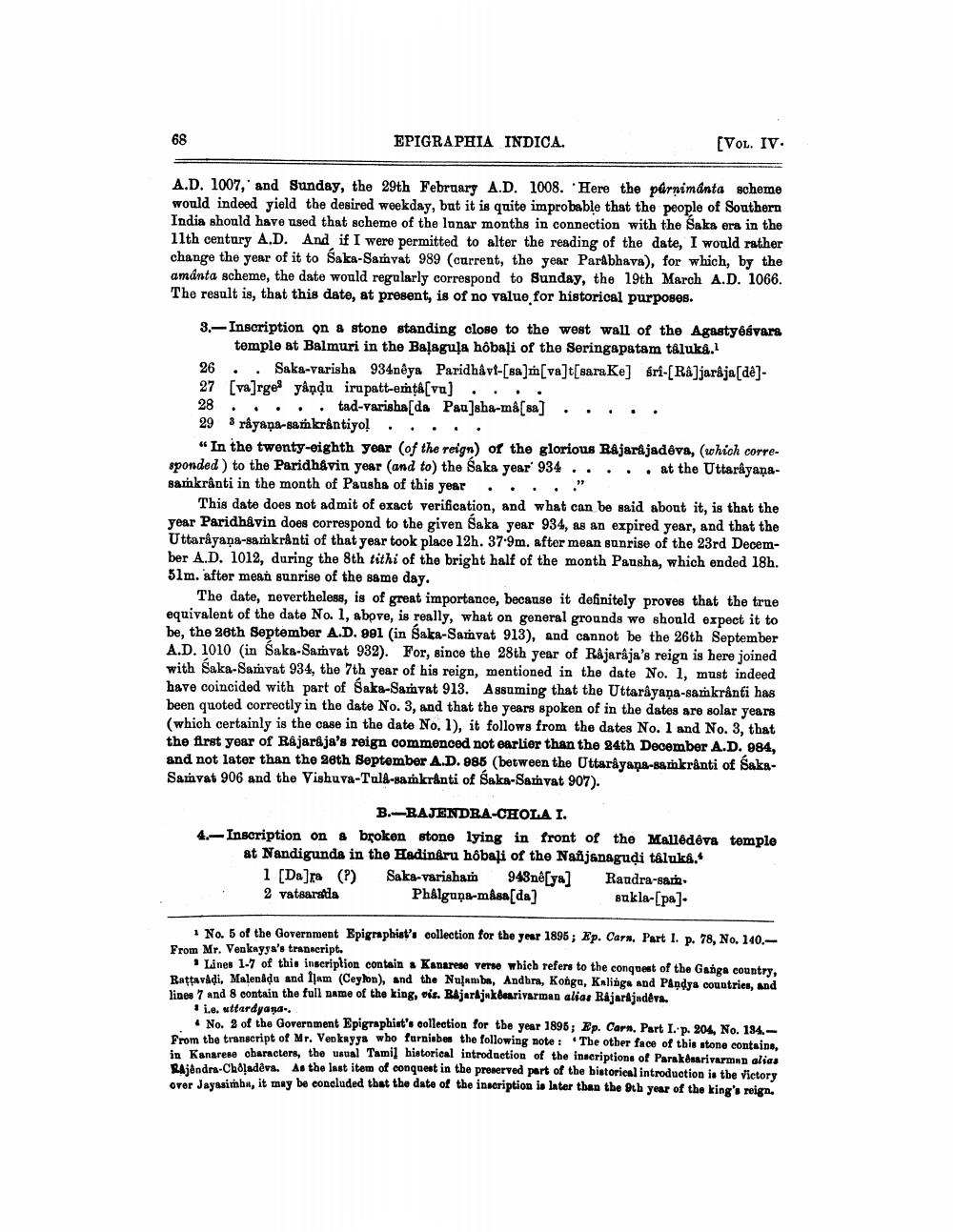________________
EPIGRAPHIA INDICA.
(VOL. IV.
A.D. 1007,' and Sunday, the 29th February A.D. 1008. Here the purnimanta scheme would indeed yield the desired weekday, but it is quite improbable that the people of Southern India should have used that scheme of the lunar months in connection with the Saks era in the 11th century A.D. And if I were permitted to alter the reading of the date, I would rather change the year of it to Saka-Samyat 989 (carrent, the year Parabhava), for which, by the amanta scheme, the date would regularly correspond to Sunday, the 19th March A.D. 1066. The result is, that this date, at present, is of no value for historical purposes.
3.- Inscription on a stone standing close to the west wall of the Agastyêśvara
temple at Balmuri in the Balagula hồbali of the Seringapatam taluka. 26 . . Saka-varisha 934neya Paridhâ vf-[sa][va]t(sara Ke] sri-[Ra]jaraja(de)27 (va]rge yându irupatt-emta[va) .... 28 ..... tad-varisha da Pau]sha-må[sa].... 29 8 râyaņa-samkrantiyo! .. .. .
"In the twenty-eighth year of the reign) of the glorious Rajarajadeva, (which corresponded) to the Paridhävin year and to the Saka year' 934 ..... at the Uttarayanasamkranti in the month of Paushs of this year . . . .."
This date does not admit of exact verification, and what can be said about it, is that the year Paridhävin does correspond to the given Saka year 934, as an expired year, and that the Uttaråyaņa-samkranti of that year took place 12h. 37-9m. after mean gunrise of the 23rd December A.D. 1012, during the 8th tithi of the bright half of the month Pausha, which ended 18h. 51m. after mean sunrise of the same day.
The date, nevertheless, is of great importance, because it definitely proves that the true equivalent of the date No. 1, above, is really, what on general grounds we should expect it to be, the 26th September A.D. 991 (in Saka-Samvat 913), and cannot be the 26th September A.D. 1010 (in Saka-Samvat 932). For, since the 28th year of Rajaraja's reign is here joined with Saka-Samvat 934, the 7th year of his reign, mentioned in the date No. 1, must indeed bave coincided with part of Saka-Samvat 913. Assuming that the Uttarayana-sankranti has been quoted correctly in the date No. 3, and that the years spoken of in the dates are solar years (which certainly is the case in the date No. 1), it follows from the dates No. 1 and No. 3, that the first year of Rajaraja's reign commenced not earlier than the 24th December A.D. 984, and not later than the 28th September A.D. 985 (between the Uttarayana-samkranti of SakaSamvat 906 and the Vishuva-Tull-samkranti of Saka-Samvat 907).
B.-RAJENDRA-CHOLA I. 4.-Inscription on a broken stone lying in front of the Malledeva temple
at Nandigunds in the Hadiniru hobali of the Nañjanagudi täluka.
1 [Da]ra (R) Saks-varisham 948ne[y] Raudra-sari. . 2 vatsaratia Phálguņa-måsa[da]
sukla-[pa].
1 No. 5 of the Government Epigraphist's collection for the year 1895; Ep. Carn, Part I. p. 78, No. 140.From Mr. Venkayga's transcript.
Lines 1.7 of this inscription contain a Kanarese verse which refers to the conquest of the Ganga country, Rattavadi, Malenadu and Ilam (Ceylon), and the Nulamba, Andbra, Konga, Kalinga and Pandya countries, and lines 7 and 8 contain the full name of the king, pis. Rajarkjakbearivarman alias Rajarajadera.
1 i.e. uttardyana..
No. 2 of the Government Epigraphist's collection for the year 1896; Ep. Carn, Part I. p. 204, No. 134.Prom the transcript of Mr. Venkayya who furnibes the following note: The other face of this stone contains, in Kanarese obaracters, the usual Tamil historical introduction of the inscriptions of Parakbaarivarman alias
Aindra-Chladeva. As the last item of conquest in the preserved part of the bistorical introduction in the victory over Jayasirnba, it may be concluded that the date of the inscription is later than the 9th year of the king's reign,




